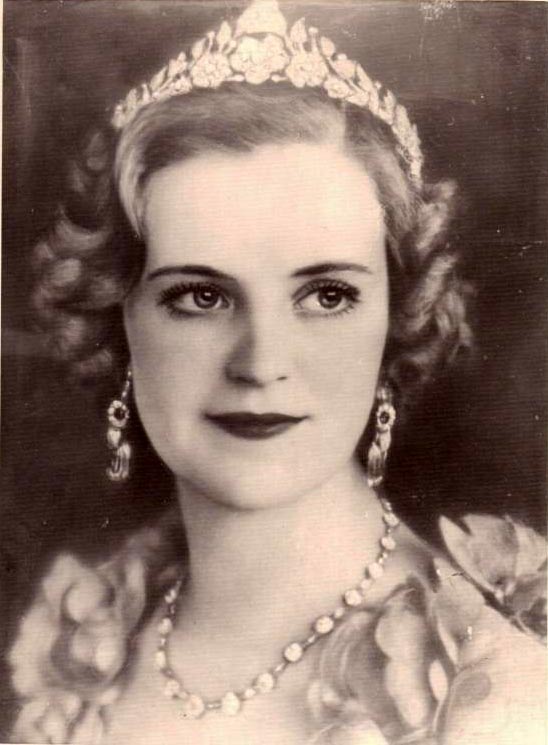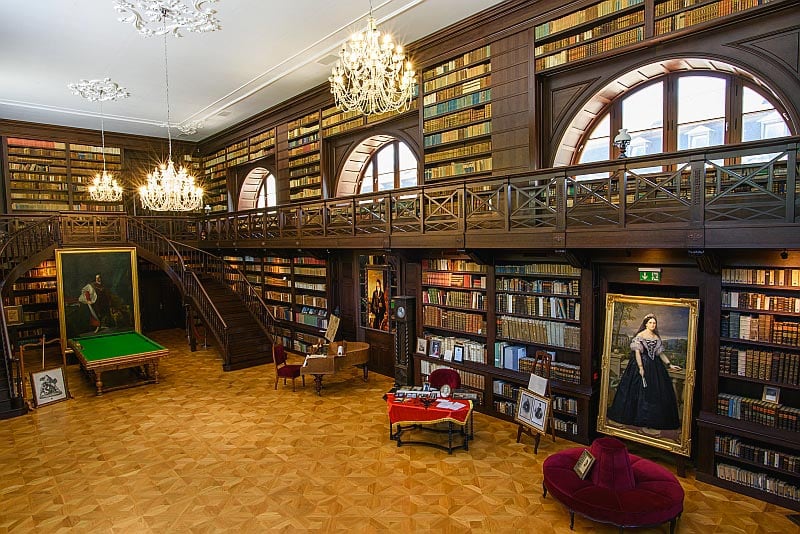Oponice located near Nitra, as the only Slovak village, can boast having given the world a queen! It was not a queen of fashion or a movie screen, but a real one. We are talking Albanian Queen Geraldine.
The eldest of the three children of Oponice Count Julius Apponyi and his American wife Gladys Virginia Steuart, was born on 6th August 1915. The father's family was one of the elite of the Hungarian aristocracy in which the family did not rank until the first half of the 18th century. Her mother's family, a woman with a particularly elegant Coco Chanel style, came from a wealthy New York family of Irish-Scottish origin. Geraldine’s mother's grandfather was in the service of American diplomacy as a consul in Antwerp.
Puccini's Mimi Enchanted a King
Young Geraldine studied at a private monastery grammar school Sacré Coeur in Pressbaum, later in the United States and Paris; in the end she completed her studies at the University of Vienna. She stayed in Budapest often. For the financial problems that plagued her family, she was forced to work as a stenographer, and she also worked at a kiosk at the Hungarian National Museum in Budapest for a short time.
She was one of the most beautiful women of her time. In addition to her charm, elegance and appeal, she also was also great at art, particularly at singing. She managed to get a soprano engagement in the Budapest opera, where she had been a resident since 1936. In the autumn of 1937 she excelled as the main act of Mimi, in the famous Puccini's opera La Bohème. Photos of the young artist with smashing reviews began to fill the pages of newspapers and magazines, as well as headlines with commentary: White Rose of Oponice.
One of the issues of these magazines got into the hands of the then 40-year-old, still single, Albanian king Ahmed Zoga I. He was originally an Albanian politician and president, and later a king, who came from a wealthy landowning family, yet he lacked a noble origin. Being aware of the need to marry and take care of the future of his family and throne, he was also interested in the origins of the charming young opera star, Countess Geraldine Apponyi. He contacted her through ambassadors. In December 1937, they approached her at one of the Budapest's aristocratic balls, and invited her to the King’s New Year's Eve celebration in Tirana's royal palace.
And so, a great romance between the Albanian king and the Countess with Slovak roots began. On New Year's Day, Zoga already proposed, and Geraldine didn’t say no. After the midnight of 1st January 1938, the king interrupted the celebration with three thousand guests, to have them listen to professing his love to the beautiful woman by his side, concluding it with proposing to her. Geraldine said yes. But the king, had to tackle two more obstacles to be able to marry the Countess of Oponice. The marriage was subject to parliamentary approval, and they also needed papal approval, as Ahmet Zoga I was a Muslim. The news about their wedding spread both through the local and world press. The date was set to 27th April 1938, and the coronation of the young Queen took place a month later.
She Got to Wear the Crown Only 345 Days
The young Geraldine of Oponice became the first and only Albanian queen in history. Her reign lasted only 345 days. She got pregnant shortly after the wedding. She quickly got used to her new homeland, learned the language, and gained the love and trust of her people. She was never selfish, and devoted her time to the needy. She founded hospitals and various charities. The happy season culminated on 5th April 1939 with the birth of the only child, Crown Prince Leka. But Europe got into World War II, Albanian people were living in a completely mistaken illusion of security. The country maintained very good diplomatic relations with Germany and especially with Italy. But it was the expansiveness of fascist Italy that deprived them of moments of peace and happiness.
There was no time left to implement the promised plan to create some sort of Swiss Balkan Switzerland. Everything was prevented by the incursion of the former "ally" - Italy and the ultimatum that Albania would become an Italian province. Mussolini's head of diplomacy, Count Ciano, one of the royal couple’s best men at the wedding cynically recalled in his memoirs that the invaders had only been waiting for the birth of a small successor to the throne. The happiness of the young family was lived short and only a few days after the birth of the Crown Prince, they had o flee abroad under the influence of the events. Thanks to having taken ten gold boxes with them, the family had their life in exile secured. Upon leaving Albania, they promised their people to return after the war. But they could not fulfil their promise for the Communist regime ... After the war, the inhabitants of war decimated Albania reached out to the Soviet Union, which was not willing to respect the king's absolute claims. The Communists set up a totalitarian regime in Albania, headed by Enver Hodza, who banned the family from entering Albania.

Hard Times in Exile of the Crownless Queen
A new life began in exile for Geraldine and her family. The escape was very complex. She was exhausted for having had delivered only recently, and the newborn heir to the throne, Leka, badly needed health care. The king secured an Armenian doctor, and it was only thanks to him that Geraldine and Leka survived this difficult journey. They escaped through Greece, Turkey, Romania, Poland, Estonia, Sweden and Norway to France. They survived World War II partly in France, later on the British Isles in the comfort of a forty-room mansion in Devant Parmoor House. But as the situation was also changing in Britain, they had to consider where to go next and where to settle. They found a temporary home in 1946 in Egypt, at King Farouk. But then they had to leave Egypt when Gamal A. Nasser took over the power in 1952. The family went to France, the Cote d'Azur.
King Ahmed Zoga I's health condition deteriorated rapidly in the early 1960s. He died on 9th April 1961 at the age of 65 in a hospital in the French town of Suresnes. After the death of his father at the Parisian Hotel Bristol, Leka, who graduated from Sorbonne and from the British Military Academy in Sandhurst, was solemnly crowned Albanian king as Leka I.
The family settled in Madrid in the residential area of Puerto del Hiero. Bulgarian czarina Yana who also lived in exile, helped Geraldine and Leka in the difficult times. She introduced them to the Spanish high society, where Geraldine established a number of valuable diplomatic contacts for Albania, a country she could not officially represent. She was the prototype of a woman who loved her homeland and was interested in her people during the time of emigration. The situation seemed to change for the better, but the opposite was true.
After the death of General Franco, and the restoration of the Spanish kingdom, they expected support from the new Spanish king Juan Carlos in the restoration of the monarchy in Albania and the accession of Leka to the throne. However, Juan Carlos did not have such an interest and their relationships gradually deteriorated. The Declaration on the occupation of Albania crowned the situation. After the Spanish police found a large number of weapons in Madrid villages, the involvement of the young Albanian king in the arms market was revealed. However, the allegations of his alleged cooperation with the ETA terrorist organization weren’t proven. The escalated situation was resolved by the Spanish authorities and by King Juan Carlos in 1979 expulsing Leka I. from Spain. Although his mother Geraldine did not have to leave Spain, she voluntarily left with her only son. They left Europe and went to South Africa, where they stayed until 2002.
Hope To Return to Homeland
After the fall of totalitarian regimes in Central, Eastern and South-eastern Europe, there seemed to come better times. Yet, the Albanian law continued to prohibit the royal family from entering the country. Despite this, Leka managed not only to get into the country in the late 1990s, but also to appear at a public gathering of monarchy supporters. The first attempt to return to the country ended in failure. There was a struggle and unrest that ended up in the shooting into the air. So the young king and his bodyguards had to leave.
At the beginning of the new millennium, Albania got rid of the totalitarian practices introduced by Enver Hodza. In 2002, the Albanian Parliament, by a majority vote, did away with not only the ban on the entry of the royal family into the country, but also the ban on its members from being in politics and government.
Coming Back Home
Sixty-three years had passed until nearly 87-year-old Queen Geraldine could return home. At the airport, the enthusiastic crowds of Albanians welcomed her.
In the summer of 2002, Geraldine’s health began to deteriorate, and after a series of severe heart attacks, her heart beat last in Tirana Military Hospital on 22nd October 2002. Thousands of Albanians accompanied her on her final journey to the Royal Mausoleum after a farewell at the Shen Pjetri Cathedral. Her son Leka, members of the Albanian royal family, government officials, prominent personalities and artists were not missing. Though she could not do more for their country, it brought a whiff of European Western culture, showing humanity, courage and perseverance. She became an icon. Her former "subjects" loved her and honour her up to this day.
Happy Childhood Home
Although she was born in Budapest, her home at the time of childhood and adolescence was Oponice (Appona in Hungarian), the residence of the family. It was the name of the residence which gave them name to the family.
Geraldine was hit by the death of her father when she was nine. After that her mother married a French officer and they moved to Menton Ville in southern France. Geraldine, together with her sister Virgina and her brother Julius, would go back to Oponice only for longer visits of their old grandmother and family, but later they came back permanently thanks to Apponyi's intervention. She left her happy home in Oponice only after the death of her beloved grandmother Margareta, in June 1931. Although, she would be less in Oponice around that time it remained her home.

Lover of literature
Locals from Oponice remembered the older daughter of Count Július Apponyi as a nice person, a glamorous girl wearing white dresses, who grew up into a charming beauty. She was also popular with the locals for her good command of the Slovak language. She liked to remember her childhood and youth even as the Queen of Albania. She wrote in one of her letters to her fellow countrymen: "... I’ve lost touch with my old home, where I learned a bit of your language. I like to remember our village, and I have a quite a few memories for this wonderful library. I love recalling the picture of your country, peaceful forests, lakes, and rivers. Having lived there has remained with me; it's one of the places I loved dearly ... ”
The young girl loved literature in the ancient family library so much that she ended up putting together a catalogue of the most interesting books. No wonder, their library was one of the largest and richest aristocratic libraries. Only about a dozen of Viennese aristocratic libraries could compete with it; it would have been the Liechtenstein’s, Metternich’s or Schwarzenberg’s. At the time of its fame it listed 30,000 volumes, and it still is the most beautiful family library in Slovakia.